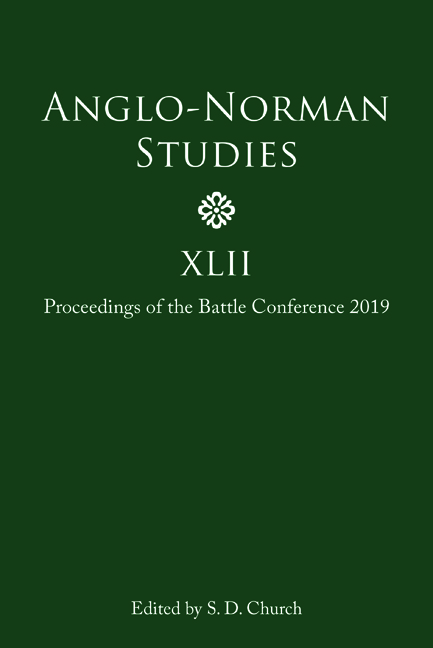Book contents
- Frontmatter
- Contents
- Illustrations and Tables
- Editor’s Preface
- Abbreviations
- Reassessing the Reign of King Æthelred the Unready: (The Allen Brown Memorial Lecture)
- The Art of Memory: The Posthumous Reputation of King Harold II Godwineson: (The Des Seal Memorial Lecture)
- Women, Memory and the Genesis of a Priory in Norman Monmouth
- The Sins of a Historian: Eadmer of Canterbury, Historia Novorum in Anglia, Books I–IV
- Angevin Rule in the West of Normandy, 1154–86: The View from Mont-Saint- Michel
- ‘A girly man like you can’t rule us real men any longer’: Sex, Violence and Masculinity in Dudo of Saint-Quentin’s Historia Normannorum
- Compiling Chronicles in Anglo-Norman Durham, c. 1100–30
- The Counts of Louvain and the Anglo-Norman World, c. 1100–c. 1215
- England, Normandy and the Ecclesiastical ‘New Law’ in the Later Twelfth Century
- Miscellaneous Endmatter
The Art of Memory: The Posthumous Reputation of King Harold II Godwineson:(The Des Seal Memorial Lecture)
Published online by Cambridge University Press: 14 October 2020
- Frontmatter
- Contents
- Illustrations and Tables
- Editor’s Preface
- Abbreviations
- Reassessing the Reign of King Æthelred the Unready: (The Allen Brown Memorial Lecture)
- The Art of Memory: The Posthumous Reputation of King Harold II Godwineson: (The Des Seal Memorial Lecture)
- Women, Memory and the Genesis of a Priory in Norman Monmouth
- The Sins of a Historian: Eadmer of Canterbury, Historia Novorum in Anglia, Books I–IV
- Angevin Rule in the West of Normandy, 1154–86: The View from Mont-Saint- Michel
- ‘A girly man like you can’t rule us real men any longer’: Sex, Violence and Masculinity in Dudo of Saint-Quentin’s Historia Normannorum
- Compiling Chronicles in Anglo-Norman Durham, c. 1100–30
- The Counts of Louvain and the Anglo-Norman World, c. 1100–c. 1215
- England, Normandy and the Ecclesiastical ‘New Law’ in the Later Twelfth Century
- Miscellaneous Endmatter
Summary
As W. C. Sellar and R. J. Yeatman wrote, long ago, ‘History is not what you thought. It is what you can remember.’ I myself would go a little further: ‘history is what people want you to remember’, and if that sounds paranoid, a little paranoia never did anyone any harm and is, as far as historians are concerned, a healthy addition to their professional repertoire. The point can be illustrated by considering the posthumous reputation of King Harold II Godwineson, whose defeat at Hastings provided Sellar and Yeatman with the title of their work. Harold's fall meant the loss not only of the battle, his kingdom and his life, but also his good name, and the almost unanimous strictures on him and on his family from both medieval and modern historians warrant examination.
Harold's claim to the kingship was threefold: he had been chosen by the previous king, elected by the English magnates and consecrated in the coronation ritual. Even in near-contemporary sources there is some doubt about the first element, the designation by King Edward. All three recensions of the Anglo-Saxon Chronicle, written within a few years of the Conquest, say that Edward chose Harold as his heir, and the claim is grudgingly accepted in the panegyric on Duke William penned by William of Poitiers in the early 1070s. The Bayeux Tapestry is more ambiguous. In its scene depicting King Edward's deathbed only the dying king is identified by name, and the text says merely that he is speaking to his faithful companions (hic Eadwardus rex iniecto alloquit fideles), with no hint of what he is actually saying. The other participants in the scene can be identified from the more or less contemporary description of the king's deathbed in the Life of King Edward who Rests at Westminster. Here the Tapestry's ‘faithful companions’ appear as Queen Edith, ‘who was sitting on the floor warming [Edward’s] feet in her lap’, Earl Harold, Robert fitzWymarc and Archbishop Stigand, all of whom the king had summoned to hear his prophetic dream of England as a green tree, cut down and carried three furlongs from its stump before regrowing and fruiting once again.
- Type
- Chapter
- Information
- Anglo-Norman Studies XLIIProceedings of the Battle Conference 2019, pp. 29 - 44Publisher: Boydell & BrewerPrint publication year: 2020



